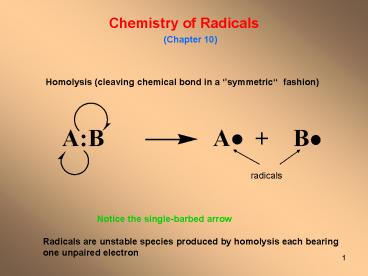Chemistry of Radicals - PowerPoint PPT Presentation
1 / 24
Title:
Chemistry of Radicals
Description:
Radicals are unstable species produced by homolysis each bearing. one unpaired electron ... Since Cl-Cl is easier to dissociate than C-H. Initiation: Cl2 2 Cl. ... – PowerPoint PPT presentation
Number of Views:644
Avg rating:3.0/5.0
Title: Chemistry of Radicals
1
Chemistry of Radicals
(Chapter 10)
Homolysis (cleaving chemical bond in a
symmetric fashion)
radicals
Notice the single-barbed arrow
Radicals are unstable species produced by
homolysis each bearing one unpaired electron
2
Formation of radicals
- Thermal cleavage of peroxides
- Photochemical cleavage of halogens
3
Reactions of radicals
Hydrogen Abstraction
.
.
.
.
Organic radical
4
An example of chain reaction
.
.
.
.
.
.
polymers
5
Cleaving a bond requires energy
Dissociation E is the inverse of bond E
DH 243 kJ/mol
DH 435 kJ/mol
6
A practical use of the bond dissociation energy
H-H Cl-Cl 2
H-Cl Edis 435 Ediss 243
Ediss 2 x (431)
862
H-H 2H.
435 Cl-Cl 2Cl.
243 2H. 2Cl.
2HCl - 862
total - 184 Reaction is
Exothermic
7
Lets consider dissociation of C-H bonds
(formation of radicals from hydrocarbons)
primary radical
CH3CH2CH2-H CH3CH2CH2. H.
Ediss 410 (CH3)2CH-H
CH3CHCH3 H. Ediss 395
secondary radical
Thus stability of radicals depends on their
nature 3 gt 2 gt 1
8
Hyperconjugation for relative stabilization of
radicals
Partly vacant p orbital
The partly vacant orbital will receive part of
electron density from the neighboring orbitals.
More atoms around, more stabilization
9
Exercise List the followings radicals in order
of decreasing stability CH3.
(CH3)2CHCH2. CH3CH2C(CH3)2
CH3CH2CHCH3
.
.
10
Exercise List the followings radicals in order
of decresasing stability CH3.
(CH3)2CHCH2. CH3CH2C(CH3)2
CH3CH2CHCH3
.
.
Methyl primary
tertiary secondary
11
Exercise List the followings radicals in order
of decresasing stability CH3.
(CH3)2CHCH2. CH3CH2C(CH3)2
CH3CH2CHCH3
.
.
Methyl primary
tertiary secondary
Mister unstable
Mister stable
12
Reactions of alkanes with X2
CH4 Cl2 CH3Cl CH2Cl2
CHCl3 CCl4 HCl
(a very unselective halogenation reaction)
The reaction proceeds step by step CH3Cl is
generated first further reaction produces CH2Cl2
and so on.
CH3 CH3
CH3 CH3CHCH3
CH3CHCH2Cl CH3CCH3 Polychl. HCl
Cl
Cl2
light
13
The mechanism
CH4 Cl2 CH3Cl HCl
Reaction is promoted by either light or
heat Since Cl-Cl is easier to dissociate than C-H
Initiation Cl2 2
Cl. Propagation CH4 Cl
CH3 HCl
CH3 Cl2 CH3Cl
Cl Termination CH3 Cl
CH3Cl Cl
Cl Cl2
CH3 CH3 CH3CH3
DH 243 kJ/mol
.
.
DH 4 kJ/mol DH - 106 kJ/mol DH
- 349 kJ/mol DH - 243 kJ/mol DH -
368 kJ/mol
.
.
CH4 Cl2 CH3Cl HCl DH
- 102
.
.
.
.
.
.
14
Initiation Cl2 2
Cl.
DH 243 kJ/mol
Also called Activation Energy (E)
15
.
.
Termination CH3 CH3
CH3CH3
DH - 368 kJ/mol
E 0
16
Propagation CH4 Cl
CH3 HCl
.
.
Bond breaking and forming do not occur
simultaneously but step by step. Thus,
transformations occur via formation of an
unstable state where bonds are partly broken
and partly formed. This species is called
transition state and is high in energy
17
CH4 Cl CH3 HCl
(DH
431) CH4 Br CH3
HBr (DH 366)
18
Reaction of CH4 with different halogens
Fluorination
DH E 159
159 -134 5 -293
small -427
Initiation
F2 2
F. Propagation CH4 F
CH3 HF CH3
F2 CH3F F
overall
19
Reaction of CH4 with diffrent halogens
Chlorination
DH E 243
243 4 16 - 106
small - 102
Initiation
Cl2 2
Cl. Propagation CH4 Cl
CH3 HCl
CH3 Cl2 CH3Cl Cl
overall
20
Reaction of CH4 with different halogens
Bromination
DH E 192
193 69 78 - 100
small - 31
Initiation
Br2 2
Br. Propagation CH4 Br
CH3 HBr
CH3 Br2 CH3Br Br
overall
21
Reaction of CH4 with different halogens
Iodination
DH E 151
151 138 140 - 84
small 54
Initiation
I2
2I. Propagation CH4 I
CH3 HI CH3
I2 CH3I I
overall
F2 gt Cl2 gt Br2 gt I2
Halogen dissociation E clearly not responsible E
of the first propagation step is responsible
22
Halogenation of higher alkanes
According to statistics presuming equal
probability of reacting
23
But experimentally ..
30 22
33 15
- Thus, there are two players
- Statistical factor
- Stability of the radical (3gt2gt1)
24
Selectivity of bromine
(99)
(traces)
F (99) (1)






























